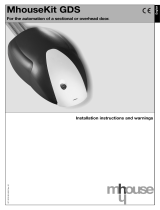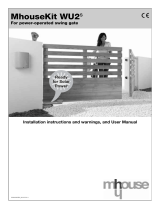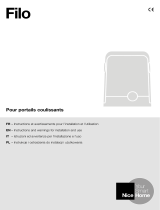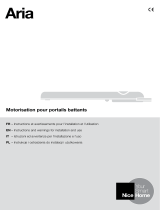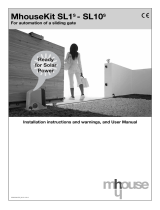Page is loading ...

1 – English
EN
The following warnings are taken directly from the Regulations and apply, as far as possible, to the product described herein
WARNING Important safety instructions. Observe all the instructions as improper installation may cause serious damage
WARNING Important safety instructions. It is important to comply with these instructions to ensure personal safety. Store these
instructions
• Beforecommencingtheinstallation,checkthe“Producttechnicalspecications”,inparticularwhetherthisproductissuitableforautomating
your guided part. Should it be unsuitable, DO NOT proceed with the installation
• Theproductcannotbeusedunlessithasbeencommissionedasspeciedinthe“Testingandcommissioning”chapter
WARNING According to the most recent European legislation, the implementation of an automation system must comply with
the harmonised standards set forth in the Machinery Directive in force, which allow for declaring the presumed
conformity of the automation. On account of this, all operations regarding connection to the mains electricity, as
well as product testing, commissioning and maintenance, must be performed exclusively by a qualied and skilled
technician!
• Before proceeding with the product’s installation, check that all materials are in good working order and are suitable for the intended
applications
• The product is not intended for use by persons (including children) with reduced physical, sensory or mental capacities, nor by anyone lack-
ingsufcientexperienceorfamiliaritywiththeproduct
• Children must not play with the appliance
• Do not allow children to play with the control devices of the product. Keep the remote controls out of reach of children
WARNING In order to avoid any danger from inadvertent resetting of the thermal cut-off device, this appliance must not be powered through
anexternalswitchingdevice,suchasatimer,orconnectedtoasupplythatisregularlypoweredorswitchedoffbythecircuit
GENERAL WARNINGS: SAFETY - INSTALLATION - USE
(instructions translated from Italian)
ENGLISH

English – 2
EN
• Provide a disconnection device (not supplied) in the plant’s mains power supply, with a contact opening distance that ensures complete
disconnection under the conditions envisaged by Overvoltage Category III
• Handle the product with care during installation, taking care to avoid crushing, knocks, falls or contact with liquids of any kind. Keep the
productawayfromsourcesofheatandopenames.Failuretoobservetheabovecandamagetheproductandincreasetheriskofdanger
or malfunctions. If this should happen, stop installation immediately and contact the Customer Service
• The manufacturer assumes no liability for damage to property, items or persons resulting from non-compliance with the assembly instructions.
In such cases the warranty does not cover material defects
• Cleaning and maintenance to be carried out by the user must not be effected by unsupervised children
• Before intervening on the system (maintenance, cleaning), always disconnect the product from the mains power supply
• The packaging materials of the product must be disposed of in compliance with local regulations
• When performing a manoeuvre, keep an eye on the automated mechanism and keep all bystanders at a safe distance until the movement
has been completed
• Do not operate the automation if any people in the vicinity are working on it; disconnect the power supply before permitting any work to be
carried out
PRODUCT DESCRIPTION AND INTENDED USE
1
MC200 is an electronic control unit that allows for controlling and commanding a motor designed to automate a shutter, overhead door, sectional
door, rolling shutter or other similar applications.
WARNING! - Any use other than that specied herein or in environmental conditions other than those stated in this manual is
to be considered improper and is forbidden!
Functionalcharacteristics:
•itconnectstothemainspowersupply(seedatainthechapter,“Producttechnicalspecications”);
• it can be programmed by setting 8 dip-switches;
• it is equipped with an incorporated radio receiver that allows for controlling the automation through a radio transmitter;
•variousaccessoriescanbeconnectedtothecontrolunit,suchas:apairofphotocells,awarninglight(poweredatthemainsvoltage)forlu-
minouswarnings,awall-mountedbuttontocontroltheautomationwith“step-by-step”-typecommands,anexternalradioantenna,asensitive
edge, etc.
•itisequippedwithatype“IBT4N”connector,compatiblewiththeIBT4Ninterface,whichallowsforconnectingalldevicesequippedwithBusT4
interface,suchas,forexample,Oviewprogrammingunits.

3 – English
EN
USE LIMITATIONS
2
•TheMC200controlunitcanbeusedexclusivelywithanasynchronoussingle-phasemotor.Themotormustbe:a) powered from the mains
and sized for the same voltage that powers the control unit; b) equipped with a thermal cut-off; c) equipped with a mechanical device that limits
its movement (limit switch); d)equippedwithconnectionsto3conductors:“Common”,“Open”and“Close”.
• The radio receiver incorporated in the control unit is only compatible with transmitters that adopt the FLOR, O-CODE or SMILO radio coding
protocols (these are Nice standards).
•Furtheruselimitationsarespeciedinthe“Producttechnicalspecications”chapter.
INSTALLATION
3
Important! - Prior to installing the product, check its use limitations by reading Chapters 2 and 7.
Check that the temperature is suitable for the type of application.
The product must not be installed outdoors.
When drilling the control unit box for passing the cables (Fig. 1-C), it is important to remember that the cables must always
enter the box from below. Moreover, take suitable precautions to guarantee the required protection rating (IP 44) for the type of
installation.
Before proceeding with the installation, prepare the electrical cables required for the system by referring to Fig. 2b and to “Table
1 - Technical specications of electrical cables”.
Warning! – When laying the tubes for protecting the electrical cables and when laying the cables into the control unit housing,
bear in mind that due to possible water deposits in the junction wells, the cable protection tubes might create water vapour the
control unit, with consequent damage to the electronic circuits.
Install the control unit by referring to Fig. 1.

English – 4
EN
45 mm128 mm
112 mm
1
2
2
1
Ø 3,5 x 35
x 2
Electrical
connections.
Refer to Chapter 4
A B C
D E F G
If necessary,
use the cable
entry openings
at the rear of the
box,but only
with suitable
tubettings.
Drill the
underside
of the
control
unit box.
1

5 – English
EN
ELECTRICAL CONNECTIONS
4
WARNING! – All electrical connections must be made with the system disconnected from the power supply. Incorrect connec-
tions can damage the equipment or injure people.
WARNING! – The connections must only be carried out by qualied personnel.
4.1 - Arranging the electrical cables to connect devices to the control unit (Table A)
Table A - Characteristics of electrical cables for the relevant connections
Device to be connected Cable cross-section Maximum cable length
POWERSUPPLYFORTHECONTROL
UNIT
1cable:2x1.5mm
2
30 m (*1)
WARNING LIGHT WITH RADIO AN-
TENNA
1cable:2x1.5mm
2
(for the lamp)
1RG58-typeshieldedcable(foraerial)
20 m
20m(recommended<5m)
DEVICES CONNECTED TO TERMINALS
8-9-10-11-12-13
6cables:1x0.5mm
2
(*2) 50m
POWERSUPPLYFORMOTOR 3cables:1x1.5mm
2
10 m
(*1) –Ifthepowercableislongerthan30macablewithlargercross-sectionaldimensionsisrequired,forexample,2x2.5mm
2
.
(*2)–These6cablescanbereplacedbyasingle6x0.5mm
2
cable.
WARNING! – The cables used must be suited to the type of environment of the installation site.
4.2 - List of control unit parts
During the successive control unit connection and programming phas-
es,toidentifythecomponentsmentionedinthetextrefertoFig. 2
and its key.
A - Line fuse (6.3 A)
B - Connector for inserting the IBT4N interface
C - “OK”LED
D - “Radio”LED
E - T2 button, for memorising a transmitter and for cancelling a trans-
mitter or the entire control unit memory
F - T1 button, for programming and for sending step-by-step com-
mands
G - Dip-switch for programming the functions

English – 6
EN
H - LEDforinputs(“Stop”,“SbS”,“Photo”)
I - Terminals for radio antenna
L - Low-voltage input terminals
M - Terminals for connecting the power supply line and for the motor
12345678
CLN
Com
0V
24V
Photo
Test
Photo
SbS
Stop
2
A
M
L
B
C
D
E
G
F
H
I

7 – English
EN
4.3 - Basic connections
• Connecting the motor to the MC200 control unit
Connect the 3 conductors coming from the motor (Up phase, Common, Down phase) respectively to terminals 3, 4 and 5 of the control unit,
as shown in Fig. 3.
WARNING! Before connecting the motor, it is imperative to verify that the conductor connected to terminal 3 causes the door to
OPEN, that the conductor connected to terminal 5 causes the door to CLOSE, and that the conductor connected to terminal 4
is the COMMON conductor.
Warning! – Donotconnectmultiplemotorsinparalleltothesamecontrolunit,unlessexpresslyenvisagedinthemotor’sinstructionmanual;
inthiscase,usetheappropriateexpansionboards.
• Connecting the power supply to the MC200 control unit
Connect the 2 wires coming from the mains (Live and Neutral) respectively to terminals 6 and 7 of the control unit, as shown in Fig. 3.
• Earthing the motor
Warning! - To comply with the electrical safety requirements of the relevant product class (Class II), it is mandatory to earth the motor outside
of the MC200 control unit.
3
“S”
11
8
8,2kΩ
8,2kΩ
4
Sensitive edge

English – 8
EN
4.4 - Connection of accessories
To connect the relevant accessories refer to Table B, to Fig. 3 and to the instruction manual of each accessory. Table B summarises all the ac-
cessoriesthatcanbeconnectedtothecontrolunitterminalsandthespecicationsformakingtheelectricalconnections.Before proceeding,
carefully read the table and its notes. Note – Due to the fact that certain inputs offer different functions for connecting the accessories, once the
connectionshavebeenmadeitwillbenecessarytosetthedip-switchesaccordingtotheaccessoriesconnected(seeChapter5-Programming).
Table B-Functionoftheterminals(inputsandoutputs)
Terminals Description of the function
1 - 2 Outputforashingwarninglightatthemainsvoltage.
3 - 4 - 5 Output for controlling the motor (open, common, close).
6 - 7 Input of the power supply line coming from the mains (live, neutral).
8 Reference to 0 V for the “Common”conductorofthedevicesconnectedtoterminals9, 10, 11, 12 and 13.
9 24 V output.Outputfordevices(forexample,photocells)with24V
powersupply(low-voltage):maximumcurrentdraw:100mA.
10 Photo test output. 24 V
outputforatransmissionphotocell(TX)orfora“dooropenindicatorlight”function.Maximumcurrentdraw:50mA.
11 Stop input. Input forsafetydeviceswith8.2kΩxedresistor(sensitiveedge,etc.).
12 SbS input. Input for a normally open (NO) button, for sending commands in step-by-step mode.
13 Photo input. Input for a normally closed (NC) reception photocell (RX), or for a normally open (NO) button.
14 - 15 Input for an antenna-radio receiver.
4.5 - How to manage the “Photo test” output and the “Stop”, “SbS” and “Photo” inputs
4.5.1 - Photo test output (terminal 10)
Thisoutputmustbeconguredthroughprogrammingdip-switch7dependingonthetypeofdeviceconnected:ifatransmissionphotocell(TX)
isconnected,thedip-switchmustbesettoON;ifinsteada“dooropenindicatorlight”isconnected,thedip-switchmustbesettoOFF.
NOTES•Ifa“dooropenindicatorlight”isconnectedtothisoutput,theTXphotocellmustbeconnectedtoterminal9. • The “door open indica-
torlight”signalshavethefollowingmeanings:
light off = door closed; light on = door open; slowashing = door in opening phase; fastashing = door in closing phase.
4.5.2 - Stop input (terminal 11)
Thisinputmustbeconguredthroughprogrammingdip-switches1 - 2 depending onthetypeofdeviceconnected: normally closed (NC) con-
tacts,normallyopen(NO)contactsorxedresistance(8.2kΩ)contacts. Warning!-Onlytheuseofaxedresistancecontacttogetherwith
theOFF+OFFsettingofdip-switches1 - 2 guarantees the minimum level of resistance against faults, requested by the regulations. Normally the

9 – English
EN
intervention of the device connected to the Stop input causes the immediate stoppage of the motor’s movement, with a brief inversion of the
manoeuvre (selectable through dip-switch 3).Todeactivatethisinversionfollowingtheinterventionofthesafetydevice(forexample,whenthe
sensitiveedgetouchestheoor),itispossibletousean“S”contact(with8.2kΩxedresistorconnectedinseries)tobeconnectedinparallel
to the sensitive edge (see Fig. 4). The “S” contact must be placed so that it closes in the last 30/40 mm of the closing manoeuvre, before the
sensitive edge intervenes. In this way, when the “S”contactclosesandthesensitiveedgeintervenes(forexample,ontheoor),theautoma-
tion stops without inverting the manoeuvre and the door remains fully closed. In this condition, the system allows for commanding the opening
manoeuvre only.
The status of the Stop inputissignalledbythe“Stop”LEDwiththemeaningsspeciedinTable C.
Table C-Statusofthe“STOP”inputsignalledbytherelativeLED
“Stop” LED signal Meaning (status of the Stop input)
On Active (consent for manoeuvre)
Off Not active (manoeuvre stopped)
50% on + 50% off Inversion deactivated
20% on + 80% off Not active, with inversion deactivated (allowed only after the opening manoeuvre)
4.5.3 - SbS input (terminal 12)
Whenever the button connected to this input is pressed, the system runs the command following the last command sent, according to a default
sequencewhichcanbeprogrammedthroughdip-switch5(forexample,>open>stop>close>stop>again...).Ifthecontrolbuttoniskept
pressed (from 4 to 10 seconds), the system always commands an opening manoeuvre; if instead the button is held for more than 10 seconds, the
system always commands a closing manoeuvre. This particular function can be useful whenever there are multiple control units, when the user
wishes to control them simultaneously and have the doors perform the same manoeuvre, regardless of the current status of each control unit.
4.5.4 - Photo input (terminal 13)
Thisinputmustbeconguredthroughprogrammingdip-switch4dependingonthetypeofdeviceconnected:ifanormallyclosed(NC)recep-
tionphotocell(RX)isconnected,thedip-switchmustbesettoOFF;ifinsteadanormallyopen(NO)buttonisconnected,thedip-switchmust
be set to ON. Note – If a normally closed (NC) reception photocell (RX) has been connected, if there is no consent only the opening manoeuvre
can be carried out.

English – 10
EN
PROGRAMMING
5
IMPORTANT! - After making all the connections, power the control unit and set the eight dip-switches on the board, on the basis
of the type of devices connected and the functions to be activated or deactivated. Refer to Table D for programming the unit.
Table D - Setting the dip-switches
Dip-switch Setting Description of the set function
Switches
1 - 2
(1) OFF; (2) OFF
Enables the Stop input for the connection of a 8.2kΩfixedresistor,withoutbutton“S”thatexcludestheinversion
(see Fig. 4)
(1) OFF; (2) ON
Enables the Stop input for the connection of a 8.2kΩfixedresistor,withbutton“S”thatintervenesat30/40mmfrom
thelimitswitchtoexcludeinversion (see Fig. 4)
(1) ON; (2) OFF Enables the Stop input for the connection of a NO (normally open) contact
(1) ON; (2) ON Enables the Stop input for the connection of a NC (normally closed) contact
Switch 3
OFF
Enables the Stop input to stop the current manoeuvre and perform a brief inversion of the movement
ON Enables the Stop input to stop the current manoeuvre
Switch 4
OFF Enables the Photo input for the connection of photocells
ON Enables the Photo input for being used as a closing command
Switch 5
OFF Enablesthefollowingcyclicalcommands,ofthestep-by-steptype:>Open>Stop>Close>Stop>(again...)
ON Enablesthefollowingcyclicalcommands,ofthestep-by-steptype:>Open>Stop>(again...)
Switch 6
OFF Disables the condominium function
ON Enables the condominium function
Switch 7
OFF Enablesthe“Dooropenindicatorlight”function
ON Enables the Photo Test function
Switch 8
OFF Disablesthe“PauseTime”fortheautomaticre-closingofthedoor,followinganopeningcommand
ON Enablesthe“PauseTime”fortheautomaticre-closingofthedoor,followinganopeningcommand

11 – English
EN
5.1 - Insights on certain programmable functions and options
5.1.1 - Dip-switches 1 and 2 (for the Stop input)
Thesedip-switchesareusedtoprogrammetheStopinputonthebasisofthetypeofsafetydeviceconnected:
-Contactwith8.2kΩxedresistance,withinversion.
-Contactwith8.2kΩxedresistance,withoutinversion.
- NO (normally open) contact.
- NC (normally closed) contact.
5.1.2 - Dip-switch 5 (for the SbS input)
IftheSbSinputisprogrammedwiththestep-by-stepsequenceofcommands:> Open > Stop > (again...),therefore,withdip-switch5setto
ON, during use of the automation it will not be possible to command the closing of the door. This command can only be given by programming
the automatic re-closing (dip-switch 8 set to ON), or through a radio transmitter.
5.1.3 - Dip-switch 6
• During an opening manoeuvre: if the condominium function is enabled (dip-switch 6 set to ON), it prevents the stoppage of the manoeuvre
after an opening or step-by-step command is sent, or its inversion prior to terminating at the limit switch.
• During a closing manoeuvre: if the condominium function is enabled (dip-switch 6 set to ON), the sending of an opening or step-by-step
command stops the manoeuvre and inverts its movement, making the door open.
5.2 - Memorisation of the dip-switch settings
After setting all the dip-switches (or later on, whenever the user wishes to modify the setting of one or more dip-switches), it is necessary to
memorisethesettingsinthecontrolunit,inthefollowingway:whenthe“OK” LEDstartsashing(green/red)itmeansthatoneormoredip-
switches has been shifted. Therefore, to memorise the new setting press and hold button T1 on the control unit, until the “OK” LED remains
steady lit green. Subsequently, release the button.
5.3 - Programming the “Work Time” of the motor and the “Pause Time” for automatic re-closing
The“WorkTime”andthe“PauseTime”are two basic parameters of the control unit and are programmed one after the other, with the same
procedure. These parameters can only be programmed once all the dip-switches have been set and memorised.
• What is the “Work Time”?Itisthemaximumdurationforwhichthecontrolunitkeepsthemotorpoweredfromthetimeacommandissent.
This duration must be long enough for the motor to complete the manoeuvre (up to the limit switch). The default setting (or after the memory
isfullydeleted)is120seconds.Howeverthisvaluecanbemodiedbyprogrammingadurationof5seconds(minimum)upto120seconds
(maximum).Theprocedureentailsmeasuringthetime–inself-recognitionmode–requiredforthemotortocompleteamanoeuvre.Forthis
reason it is necessary to measure the most strenuous manoeuvre for the gate (i.e. the slowest one), which normally corresponds to the start of

English – 12
EN
a movement from a limit switch. Warning! - It is advisable to programme a slightly longer duration (by a few seconds) with respect to the time
necessary to complete the manoeuvre.
• What is the “Pause Time”? It is the time for which the control unit waits to re-close the door automatically, once the user has sent an opening
command(function:automatingre-closing).TheprogrammablePauseTimelastsfrom5seconds(minimum)to120seconds(maximum).The
PauseTimecanalsobeeliminatedentirely:thisservestodisable automatic re-closing.
To memorise the “Work Time” and the “Pause Time”
01.
Bring the door to the low limit switch.
02.
Press and hold button T1onthecontrolunit:assoonasthemotorstartsmovingtowards the high limit switch,startcounting5sec-
onds.Attheendofthe5secondsthe control unit will start memorising the duration of the manoeuvre;
03.
Continue holding button T1; wait for the manoeuvre to end at the high limit switch; wait a few seconds more and then release the but-
ton. The motor will stop and the control unit will memorise the new Work Time that has just been counted.
04.
Within 2 seconds from the motor’s stoppage, press and hold button T1onthecontrolunit:fromthismomentthePause Time will start
being measured.
05.
Release button T1 after the desired time has elapsed(maximum120seconds);thecontrolunitwillcommandthemotortoperforma
downward manoeuvre while it memorises the time that has just been measured. This time will subsequently be used for the auto-
matic re-closing of the door.
IMPORTANT-TheprogrammedPauseTimewillonlybeexecutedifdip-switch8issettoON.
To modify the “Work Time” and the “Pause Time”
01. Tomodifythe“WorkTime”alone,repeattheprocedurefromthebeginningandstopatStep4.
To disable the “Pause Time”
01.
To disable automatic re-closing and, therefore, eliminate the Pause Time, repeat the procedure from the beginning and stop at Step 4.
Alternatively,theautomaticre-closingcanbedisabledbyputtingdip-switch8toOFF.

13 – English
EN
5.4 - Memorising the transmitters
The radio receiver incorporated in the control unit is compatible with all transmitters that adopt the FLOR, O-CODE or SMILO radio coding
protocols (these are Nice standards).
5.4.1 - Two procedures to memorise the transmitter button
Among the available procedures for memorising transmitters, some allow for memorising in “standard”mode (or Mode 1) and others in “custom”
mode (or Mode 2).
• STANDARD memorisation (also referred to as “Mode 1”)
Proceduresofthistypeallowforsimultaneouslymemorising–duringtheirexecution–all the buttons present on the transmitter. The system
automaticallyassociateseachbuttonwithacommandpre-definedbydefault,accordingtothefollowingtable:
Command Button
1 - Up
will be associated with 1
st
button / button 1 / s button
2 - Stop
will be associated with 2
nd
button / button 2 / n button
3 - Down
will be associated with 3
rd
button / button 3 / t button
4 - Step-by-Step
will be associated with 4
th
button / button 4 (if present on the transmitter).
Note - The transmitter buttons are normally identified by symbols and numbers. If these are not present on the transmitter, to identify the 1st button, 2nd
button, etc., refer to Fig. 5.
• CUSTOM memorisation (also referred to as “Mode 2”)
Proceduresofthistypeallowformemorising,duringtheirexecution,a single button among those present on the transmitter, by combining it
withoneofthefollowingavailablecommands:Up, Stop, Down, Step-by-Step.
The choice of the button and of the command to be paired with it is made by the installer, on the basis of the automation’s needs.
5.4.2 - Number of transmitters that can be memorised
The control unit’s receiver has 192 memory locations. A location can memorise either a single transmitter (i.e. the combination of its buttons
and commands) or a single button with the relative command.

English – 14
EN
––––––––––––– PROCEDURES –––––––––––––
WARNING! - To be able to run Procedures A, B, C, D, F, the control unit’s memory must be unlocked. If it is locked, run
Procedure G to unlock it.
PROCEDURE A - Memorising ALL buttons of a single transmitter (STANDARD mode or Mode 1)
01. On the control unit:pressandholdbutton T2 until the “radio” LED lights up; then release the button.
02.
(within 10 seconds) On the transmitter to be memorised:pressandholdanybuttonandwaitforthe“radio” LED to emit 3(*) long
ashes(=memorisationcompletedcorrectly).Lastly,releasethebutton.
03. Note-Afterthe3longashesafurther10secondsremaintomemoriseanadditionaltransmitter(ifdesired),startingfromStep02.
Attheendoftheprocedure,thetransmitterbuttonswillbepairedwiththecommandsspeciedintheMode1description(Paragraph5.4.1).
PROCEDURE B - Memorising a SINGLE BUTTON of a transmitter (CUSTOM mode or Mode 2)
01. Fromthetablebelowchoosethecommandtobepairedwiththerelevantbuttontobememorised.
Choose the command To memorise the command... (Step 02)
1 - Up
...press button T2 once.
2 - Stop
...press button T2 twice.
3 - Down
...press button T2 3 times.
4 - Step-by-Step
...press button T2 4 times.
02. On the control unit:pressandreleaseseveral times button T2, as indicated near the command chosen in the above table.
03.
(within 10 seconds) On the transmitter:pressandholdthedesiredbuttonandwaitforthe“radio” LED to emit 3(*) long ashes(=
memorisation completed correctly). Lastly, release the button.
04. Note-Afterthe3longashesafurther10secondsremaintomemoriseanadditionalbutton(ifdesired),startingfromStep01.
(*) - Notes to Procedures A and B:
The“radio”LEDcanalsoemitthefollowingsignals:
– 1 fast ash, if the transmitter is already memorised.
– 6 ashes, if the transmitter’s radio coding is not compatible with that of the control unit’s receiver.
– 8 ashes, if the memory is full.

15 – English
EN
PROCEDURE C - Memorising a transmitter by means of another transmitter already memorised (memorisation far
from the control unit)
This procedure allows for memorising a new transmitter by means of a second transmitter already memorised in the same control unit. This
enables the new transmitter to receive the same settings as the transmitter already memorised. The procedure does not entail any direct action
onbuttonT2ofthecontrolunit,butitsmereexecutionwithinitsreceptionrange.
01. On the transmitter to be memorised:pressandholdthebuttontobememorised.
02.
On the control unit:afterafewseconds(roughly5)the“radio” LED lights up. Release the transmitter key.
03.
On the transmitter already memorised:pressandrelease3 times the memorised button to be copied.
04.
On the transmitter to be memorised:pressandreleaseonce the same button pressed at Step 01.
PROCEDURE D - Deleting a single transmitter (if memorised in Mode 1) or a single transmitter key (if memorised in
Mode 2)
01. On the control unit:pressandholdbutton T2.
– After roughly 4 seconds the “radio” LED lights up steady (continue holding the button down).
02.
On the transmitter to be deleted from the memory:pressandholdabutton(*) until the “radio” LED(onthecontrolunit)emits5fast
ashes(or1ashifthetransmitterorbuttonisnotmemorised).
(*) Note - If the transmitter is memorised in Mode 1, any button can be pressed and the control unit deletes the entire transmitter. If the trans-
mitter is memorised in Mode 2, it is necessary to press the memorised button that must be deleted. To delete additional buttons memorised
in Mode 2, repeat the entire procedure for each button that must be deleted.
PROCEDURE E - Deleting ALL memorised transmitters
01. On the control unit:pressandholdthe“radio” button.
– After roughly 4 seconds the “radio” LED lights up steady (continue holding the button down).
– After roughly 4 seconds the “radio” LED turns off (continue holding the button down).
02.
When the “radio” LEDstartsashing,count2ashesand prepare to release the button precisely during the 3
rd
ash that follows.
03. After the deletion, the “radio” LEDashesfast.
04. Lastly, the “radio” LEDemits5longashestosignalthatthedeletionhasbeensuccessful.

English – 16
EN
PROCEDURE F - Deleting ALL the memory and restoring the default settings
01. On the control unit:pressandholdthe“radio” button.
– After roughly 4 seconds the “radio” LED lights up steady (continue holding the button down).
– After roughly 4 seconds the “radio” LED turns off (continue holding the button down).
02.
When the “radio” LEDstartsashing,count4ashesand prepare to release the button precisely during the 5
th
ash that follows.
03. After the deletion, the “radio” LEDashesfast.
04. Lastly, the “radio” LEDemits5longashestosignalthatthedeletionhasbeensuccessful.
PROCEDURE G - Locking (or releasing) the memory
WARNING! - This procedure locks the memory by preventing the execution of Procedures A, B, C, D, F.
01. Disconnect the control unit from the power supply.
02.
On the control unit:press and hold the “radio” button then power the control unit (continue holding the button down).
03. After5secondsthe“radio” LEDemits2slowashes;releasethebutton.
04.
(within5seconds)On the control unit:repeatedlypressthe“radio” buttontochooseoneofthefollowingoptions:
• LED off = Deactivation of the memory lock.
• LED on = Activation of the memory lock.
05. Fivesecondsafterlastpressingthebutton,the“radio” LEDemits2slowashestosignaltheendoftheprocedure.

17 – English
EN
TESTING AND COMMISSIONING
6
Thesearethemostimportantphasesintheautomation’sarrangementtoensuremaximumsystemsafety.
Theymustbecarriedoutbyaqualiedandexperttechnicianwhomustdenethenecessaryteststoverifythesolutionsadoptedtocounter
anyriskspresent,andcheckcompliancewithlaws,regulations,standards:inparticular,alltherequirementsoftheEN13241,EN12445and
EN12453standards.
AnysupplementarydevicesmustundergospecictestingtoverifytheiroperationandcorrectinteractionwiththeMC200controlunit.Referto
the respective user manuals.
6.1 - Testing
The testing procedure can also be performed as a periodic check of the automation devices. Each component of the system (sensitive edges,
photocells,warninglights,etc.)requiresaspecictestingphase;forthesedevices,observethetestingproceduresdescribedintherespective
instructionmanuals.Runthetestasfollows:
01. Ensurethatallspecicationsinthe“WARNINGS”chapterhavebeenstrictlyobserved
02. Using the control button or the transmitter, command the door Closing and Opening manoeuvres. During these movements, make
sure that a) the photocells (if present) intervene during the Closing manoeuvre; b) the sensitive edge (if present) intervenes with the
set mode; c) that the automatic re-closing of the door (if programmed) occurs in the closing direction. If the results of the tests do not
conform to the requirements, make sure that the electrical connections have been made correctly. In particular, refer to the warnings
stated in Paragraph 4.3.
03. Performseveralteststoverifythatthedoormovessmoothly,identifyinganyassemblyoradjustmentdefectsandpointsofexcessive
friction.
04. Verify the correct operation of each safety device present in the system (photocells, sensitive edges, etc.).
05. Checktheoperationofthephotocells(ifpresent)andanyinterferencewithotherdevices:
1-insertacylinder(withdiameter5cmandlength30cm)betweenapairofphotocells,rstnexttotheTXphotocellthennexttothe
RX photocell, to interrupt the line of sight between them;
2-verifythatthiscausestheintendedactioninthecontrolunit:forexample,theinversionofmovementduringtheclosingmanoeuvre.

English – 18
EN
PRODUCT DISPOSAL
7
This product constitutes an integral part of the automation and, therefore, must be disposed of together with it.
Similarly to the installation phase, once the product reaches the end of its useful life, the disassembly and scrapping operations must be per-
formedbyqualiedpersonnel.
This product is made of various types of materials, some of which can be recycled while others must be scrapped. Seek information on the
recycling and disposal systems envisaged by local regulations in your area for this product category.
WARNING! - Some parts of the product may contain polluting or hazardous substances which, if released into the environment,
constitute serious environmental and health risks.
As indicated by the adjacent symbol, the product may not be disposed of together with domestic waste. Sort the materials for dis-
posal, according to the methods envisaged by current legislation in your area, or return the product to the retailer when purchasing
an equivalent product.
WARNING! - Local regulations may envisage the application of heavy nes in the event of improper disposal of this product.
6.2 - Commissioning
Commissioning can only take place once all the testing phases have terminated successfully (Paragraph 6.1).
Partialor“makeshift”commissioningisforbidden.
01. Prepareandstore(foratleast10years)theautomation’stechnicalle,whichmustincludeatleast:anassemblydrawingoftheauto-
mation; the wiring diagram; the analysis of risks and solutions adopted; the manufacturer’s declaration of conformity for all the devices
installed(fortheMC200controlunitusetheannexedEUDeclarationofConformity);acopyoftheautomation’sinstructionmanualand
maintenance schedule.
02. Prepare the declaration of conformity of the automation and hand it to the owner of the automation.
03. Handovertotheownerthe“UserManual”(pull-outinsertcontainedintheautomation’smanual).
04. Draw up the maintenance schedule and hand it to the owner of the automation.
05. Before commissioning the automation, adequately inform the owner in writing regarding the attendant residual risks.

19 – English
EN
TECHNICAL SPECIFICATIONS
8
Alltechnicalspecicationsstatedhereinrefertoanambienttemperatureof20°C(±5°C).•NiceS.p.A.reservestherighttomodifyitsprod-
ucts at any time when deemed necessary, while nonetheless maintaining their intended use and functionality.
MC200 ELECTRONIC CONTROL UNIT
Power supply: from:120V
50/60Hzto:230V 50/60Hz
Maximum power of motor: 450W(ifpoweredat120V);950W(ifpoweredat230V)
Control signal voltage: roughly 24 V
Devices (terminals 8-9): voltage at roughly 24 V ;maxcurrent100mA
Safety input: incongurationwithxedresistor,mustbe8.2kΩ
Operating temperature: -20°C...+55°C
Dimensions (mm): 127x111x45
Weight (g): 300
IP rating: 44
RADIO RECEIVER (incorporated in the control unit)
Frequency: 433.92 MHz
Radio coding: FLOR,O-CODE,SMILO

English – 20
EN
EU Declaration of Conformity
(No. 629/MC200) and declaration of incorpo-
ration of “partly-completed machinery”
Note:Thecontentsofthisdeclarationcorrespondtothatstatedintheof-
cialdocumentledintheofcesofNiceS.p.A.and,inparticular,tothelatest
versionthereofavailablepriortotheprintingofthismanual.Thetextherein
has been re-edited for editorial purposes. A copy of the original declaration
can be requested from Nice S.p.A. (TV) Italy.
Revision: 0; Language: EN
• Manufacturer’s name: Nice S.p.A.
• Address: Via Pezza Alta 13, 31046 Rustignè di Oderzo (TV) Italy
• Person authorised to compile the technical documentation: Nice
S.p.A. - Via Pezza Alta 13, 31046 Rustignè di Oderzo (TV) Italy
• Product type: Control unit for 1 motor 230 V
• Model/Type: MC200
• Accessories:SeriesFLOR,O-CODE,SMILOradioremotecontrols
Theundersigned,RobertoGriffa,asChiefExecutiveOfcer,herebydeclares
underhisownresponsibilitythattheproductidentiedabovecomplieswith
theprovisionsofthefollowingdirectives:
• Directive 2014/53/EU (RED)
– Healthandsafety(Art.3(1)(a)):EN62479:2010
– Electricalsafety(Art.3(1)(a)):EN60950-1:2006+A11:2009+A12:2011
+A1:2010+A2:2013
– Electromagneticcompatibility(Art.3(1)(b)): EN301489-1V2.2.0:2017;
EN301489-3V2.1.1:2017
– Radiospectrum(Art.3(2)):EN300220-2V3.1.1:2017
In addition, the product conforms to the following directive in accordance
with the provisionsapplicable to “partly-completed machinery” (Annex II,
Part1,SectionB):
• Directive 2006/42/ECOFTHEEUROPEANPARLIAMENTANDOFTHE
COUNCILOF17May2006relativetomachineryandamendingDirective
95/16/EC(recast).
– It is hereby declared that the relevant technical documentation has been
compiled in accordance with Annex VII, Part B, of Directive 2006/42/
EC and that the following essential requirements have been applied and
fullled:1.1.1-1.1.2-1.1.3-1.2.1-1.2.6-1.5.1-1.5.2-1.5.5-1.5.6
-1.5.7-1.5.8-1.5.10-1.5.11
– The manufacturer undertakes to transmit, in response to a reasoned
request by the national authorities, relevant information on the “partly-
completedmachinery”.Thisshallbewithoutprejudicetotheintellectual
propertyrightsofthemanufacturerofthe“partly-completedmachinery”.
– Ifthe“partly-completedmachinery”iscommissionedinaEuropeancoun-
trywithanofciallanguageotherthanthelanguageusedinthisdeclara-
tion, the importer must include a translation to accompany this declara-
tion.
– The“partly-completedmachinery”mustnotbecommissioneduntilthe
nalmachineinwhichitistobeincorporatedisdeclaredtoconformto
the provisions of Directive 2006/42/EC, if applicable.
Theproductalsocomplieswiththefollowingstandards:
EN61000-6-2:2005;EN61000-6-3:2007+A1:2011;EN60335-
1:2012+A11:2014;EN62233:2008
Place and Date:Oderzo,05/09/2017
Mr. Roberto Griffa
(ChiefExecutiveOfcer)
/

